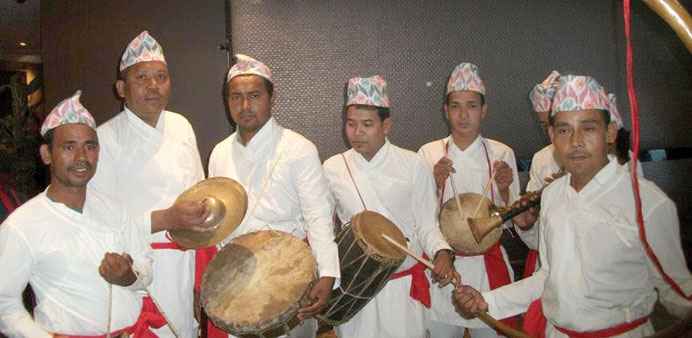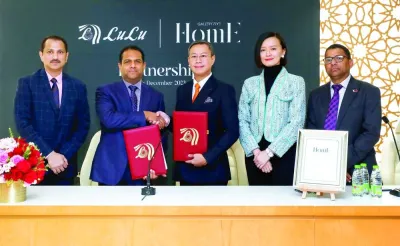CULTURAL AMBASSADORS: The panche baja band of expatriate musicians in Doha. They perform in festivals and social events but more importantly, represent Nepal during Qatar National Day and Sport Day celebrations.
The panche baja band is an integral part of the Nepalese folklore. In
Doha, a group of expatriate musicians carry forward the tradition
By Usha Wagle Gautam
Individually they can carry a tune, but collectively they can play harmonies unique to the Nepalese folklore. A typical panche baja band, ethnic to most parts of Nepal, needs a quintet, one instrument for each member. There is a custom of performing panche baja during festivals, weddings and other celebrations in Nepal.
Among the five, three are percussion instruments — dholki, tyamk and damaha. Dholki is a two-sided drum whilst tyamk and damaha are kettle drums. Shahanai, the third folk oboe, is a pipe instrument, and is often the source of the melancholic wail for its long, deep and nostalgic sound. Jhyali or jhurma the fifth one, also a percussion instrument, is a kind of a cymbal.
Among others, panche baja musicians usually come from the so-called low-caste Nepalese communities — Damaii (tailor) and Gaine (musician). The addition of two other instruments, narshingha and karnal, with panche baja makes it naumati baja, creating a more improvised sound. Narshingha is a long S-shaped trumpet and karnal is a big-mouthed straight trumpet with a bell.
Nepalese expatriate Som Pariyar, a dholki performer, is part of a panche baja band in Doha. Pariyar, who has performed at Qatar National Day and Sport Day celebrations says about the instrument: “The smaller head is played with the hand, and the larger is often, though not always, is played with a stick.”
The dholki heads are often made with animal tans, preferably of cow, goat or buffalo skins and are prepared by Baadi communities of west Nepal.
According to Pariyar, some musicians make their own dholki, but often they buy from the professional drum-makers, who also make other percussion instruments like madal and tyamko.
To play a dholki, the instrument is fastened it with a shoulder strap so that it hangs at waist level. He adds: “A panche baja performance in Qatar wearing our national dress helps to spread our native culture onto an international arena.”
Deepak Pariyar, a tyamko musician, says that the instrument he plays is also made in the same fashion as dholki or damaha. In east Nepal, tyamko is the most integral part of panche baja, often referred as the ‘guru’. In central and western regions of Nepal like Dhading and Gorkha, it is supportive to dholki, yet is considered ‘jetho’ (elder) to the ensemble of these instruments.
Pariyar says his group charges QR1,000 to 1,500 for one-day performances in Doha. The money received from the show is often sent to charity.
Babu Ram Pariyar, who plays the shahnai, says it’s a honour to perform among the Nepalese community in Qatar. Back home, Pariyar was a regular during festivals, picnics and social events.
Krishna Pariyar plays jhyali with a stroking motion that keeps the flat sides in contact with each other and produces a resonating sound. Jhyalis are thin-walled, plate shaped cymbals of varying sizes. They are usually made by Newari coppersmiths of Kathmandu and Patan, and are made out of brass or an alloy called pancha dhatu (five metals): brass, copper, silver, zinc and gold.
Krishna, who is the vice-president of Nepal Nonresident Dalit Association, says that they have formed a committee with musicians to protect and popularise Nepalese music and culture. He says the Nepalese embassy and other expatriate forums are highly supportive. He is also the co-ordinator of panche baja of Qatar.
In addition to naumati baja, sarangi, baasuri and maadal are equally popular with Nepalese communities.
Sarangi, a string instrument, often played by Gaine, is like a violin and creates the melodic mellows. Bansuri is flute while the maadal is the most popular percussion instrument of Nepal.



